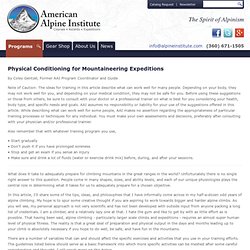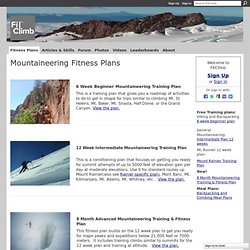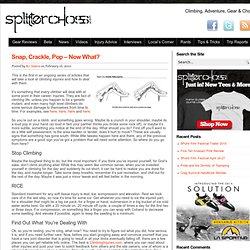

Physical Conditioning for Mountaineering Expeditions. By Coley Gentzel, Former AAI Program Coordinator and Guide Note of Caution: The ideas for training in this article describe what can work well for many people.

Depending on your body, they may not work well for you, and depending on your medical condition, they may not be safe for you. Before using these suggestions or those from others, be sure to consult with your doctor or a professional trainer on what is best for you considering your health, body type, and specific needs and goals. AAI assumes no responsibility or liability for your use of the suggestions offered in this article. While describing what can work well for some people, AAI makes no assertion regarding the appropriateness of particular training processes or techniques for any individual. Also remember that with whatever training program you use, What does it take to adequately prepare for climbing mountains in the great ranges in the world? Overview Timing: When to start training, and summary of the timeline of training. Mountaineering Fitness Plans - FitClimb. 6 Week Beginner Mountaineering Training Plan This is a training plan that gives you a roadmap of activities to do to get in shape for trips similar to climbing Mt.

St. Helens, Mt. Baker, Mt. Shasta, Half Dome, or the Grand Canyon. Eric Hörst's Training For Climbing. Rock Climbing Training. Keep the same pace and intensity during your rock climbing training workout as you would during a climbing competition or real rock climbing.

Hard tenacious training prepares you for rock climbing. Whatever the specific skill you are developing during the workout, give it 100%. Pick a rock climbing training program that will meet your goals. Keep your rock climbing training plan going all year. This will keep you in better shape mentally and physically, reduce the potential for injury, and will result in higher strength, endurance, and aerobic capacity. Target a specific function of muscle (strength, burst, or endurance). Stay in shape all year using a good climbing exercise program or it will be more difficult to get into shape and harder on your body than if you stayed in shape throughout the winter. Plan breaks in your rock climbing training to allow for recovery.
Snap, Crackle, Pop – Now What? This is the first in an ongoing series of articles that will take a look at climbing injuries and how to deal with them.

It’s something that every climber will deal with at some point in their career: injuries. They are fact of climbing life, unless you happen to be a genetic mutant, and even many high level climbers do some serious damage to themselves from time to time. For examples, see here, here, here and here. So you’re out on a climb, and something goes wrong. Maybe its a crunch in your shoulder, maybe its a loud pop in your hand (so loud in fact your partner thinks you broke some rock off), or maybe it’s more subtle, something you notice at the end of the day. Stop Climbing Maybe the toughest thing to do, but the most important. Standard treatment for any soft tissue injury is rest, ice, compression and elevation. Find Out What You’re Dealing With Ok, so you’re resting, you’re icing, what now? Go See a Doctor. ISMM - International Society for Mountain Medicine. The ISMM was founded in 1985 by the medical commission of the Union Internationale des Associations d’Alpinisme.

These doctors, involved in mountain rescue in the Swiss and French Alps, took the initiative of exchanging experiences and joining together in the teaching and research of all aspects of mountain medicine. The society‘s goals are “to create an international organization of scientific character ... and to encourage research, studies, discussion and publications concerning all medical aspects of mountains, mountain people and mountaineers.”
We hope you will enjoy your visit on our new website and are looking forward to your feedback. SincerelyBuddha Basnyat | President of the ISMM Announcement: Leh Symposium 2014: 'Ventilation and Circulation in Hypoxia: from mechanisms to patients and back' is scheduled for September 19-23, 2014 at Leh, Ladakh, Jammu & Kashmir India.